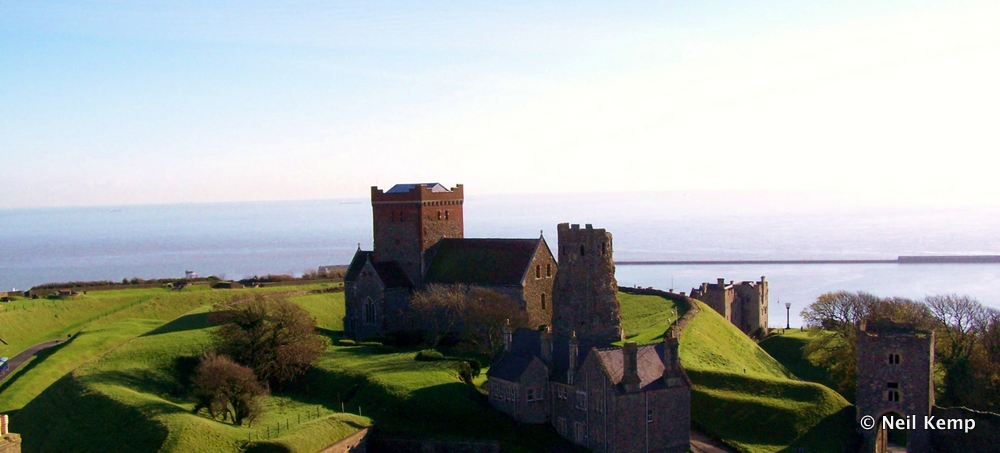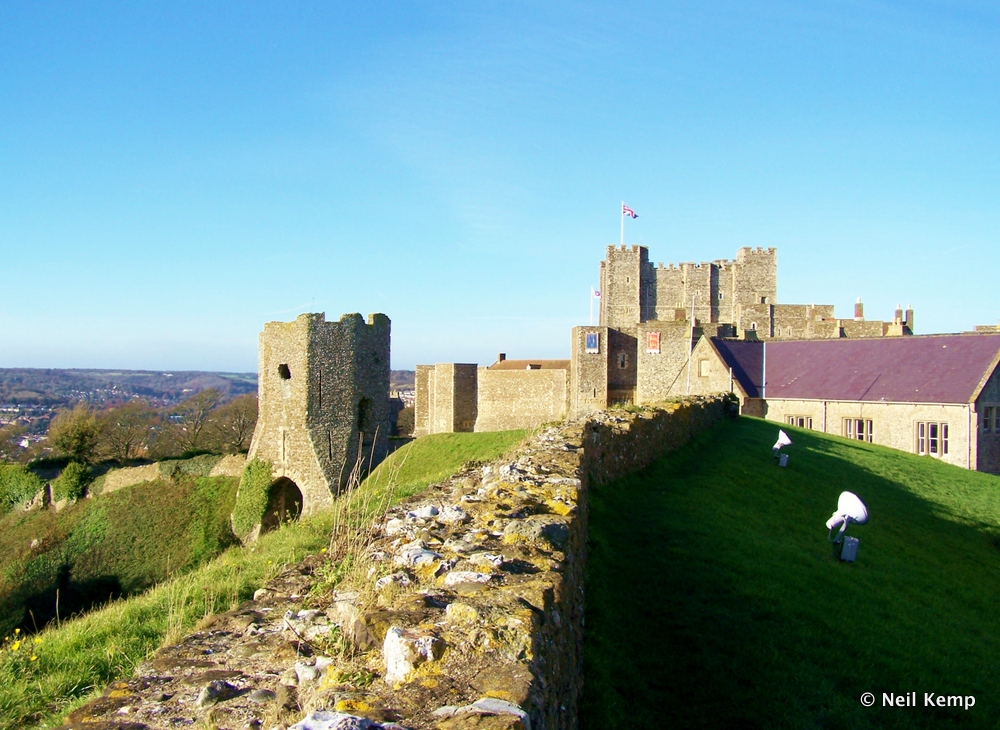
Dover Castle probably fits most people’s idea of a classic medieval fortress. Incorporating a square keep at its heart, it was surrounded by concentric rings of stone walls with regularly spaced wall towers, a combination which made Dover Castle one of the most powerful of all medieval castles.
Situated high on the hilltops overlooking Dover harbour, the castle secured a vitally strategic position in guarding the Strait of Dover at the narrowest point of the English Channel, which has seen traffic between Britain and the Continent for thousands of years.
Dover’s medieval fortress was built on the site of an Iron Age hill fort which had existed there many centuries before. After AD 43 it was occupied by the Romans and a Roman lighthouse is still contained within the castle’s walls. Next to this lighthouse stands an Anglo-Saxon church dating from around the year 1000, which although heavily restored during the 19th century, still retains many original features and is the largest and finest Saxon building in Kent.
The site was occupied and strengthened by Norman forces after William the Conqueror’s victory at Hastings in 1066, with an earth bank, ditches and walled fortifications surrounding the church and lighthouse by 1100. this being the main defensive area at that time.
Henry wished the tower to be used as an occasional residence or as a palace for the monarch, his court and important visitors and spared no expense in its construction. The tower was completed at a cost of some £7,000, an enormous amount for the period. Henry was also keen to impress any visitors with lavish displays of opulence inside the tower, with an upper and lower chapel built into the specifications (the upper chapel being a new setting for the shrine of Thomas Becket) and a specially made blanket for his bed, made from Russian grey squirrels (there being only red squirrels in England at this time), at a cost of £1,000. If you therefore calculate the value of your modern-day home and imagine spending one seventh of its value on a blanket, then you can visualise the sheer extravagance of such an item.
Despite Henry’s dream of entertaining visiting nobles on a regular basis, in actuality the tower was seldom used for such purposes and, despite later refurbishment designed to maintain its palatial splendour, it became apparent after the conclusion of the English Civil War that the anticipated royal visits would never again occur.
The Great Tower was then used for other purposes; to house French (along with some Spanish and Flemish) prisoners of war , then as a storehouse, then as a barracks and finally as a magazine and powder store. The prisoners held in the Great Tower were taken during the Spanish War of Succession (1701-14) and many carved their names and the date of their incarceration into the stonework of the tower. Most of these “prisoner carvings” still remain and some are still easily legible today.
The castle had survived, but was badly damaged and needed an obvious strengthening of the northern defences. This work was undertaken by Hubert de Burgh, who oversaw the building of solid towers and a series of outworks projecting to the north-west, including an outer spur of earthworks which linked to the castle by a series of tunnels. These tunnels were a remarkable feat of engineering skill and are still easily accessible today.
An arrow shaped redan – a massive, detached gun battery – was built on top of de Burgh’s spur during the Napoleonic Wars and both of these features remain clearly visible when viewed from the Great Tower. Also during the period of the Napoleonic Wars, parabolic brick vaults were built above the second floor of the Great Tower, replacing the existing timber roofs in order that it would support the weight of cannons which could now be placed on the roof.
Remarkably, for an essentially medieval fortress, Dover Castle has continued to adapt and play an important strategic role in the defence of Britain, up to and even beyond World War Two. How Dover’s ancient walls and outdated defences played their part in this I shall explore next time, when I tell you about Dover Castle’s secret wartime tunnels, Operation Dynamo and the Cold War.
Even if you are not that interested in history a visit to Dover Castle is well worth the admission price and is an experience that I heartily recommend.

Neil Kemp is a keen and passionate amateur historian and prize winning photographer who lives in Margate, on the North Kent coast in the United Kingdom. Before retiring he worked both with and at Margate Museum, overseeing budgets on a number of historical projects.
